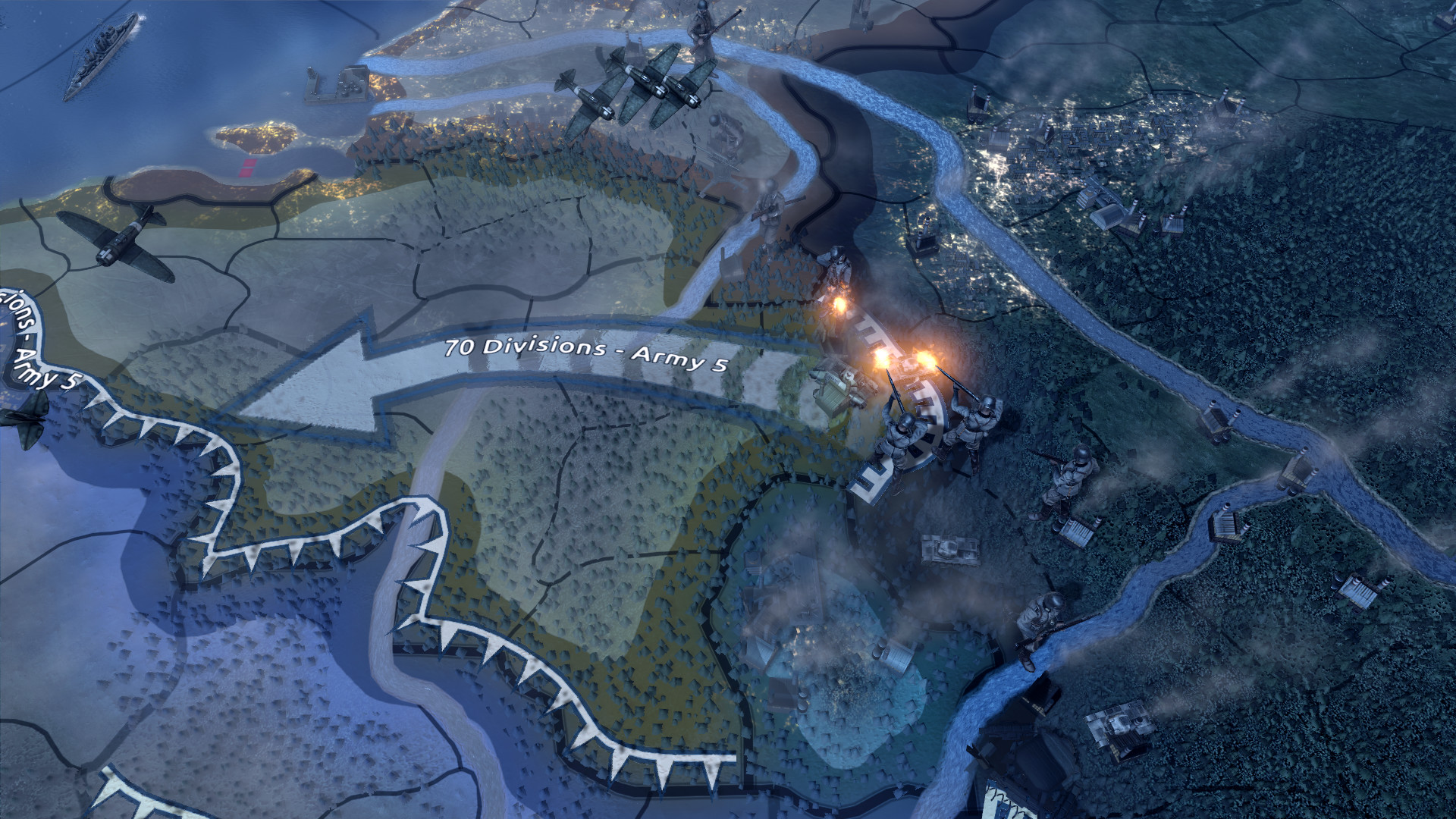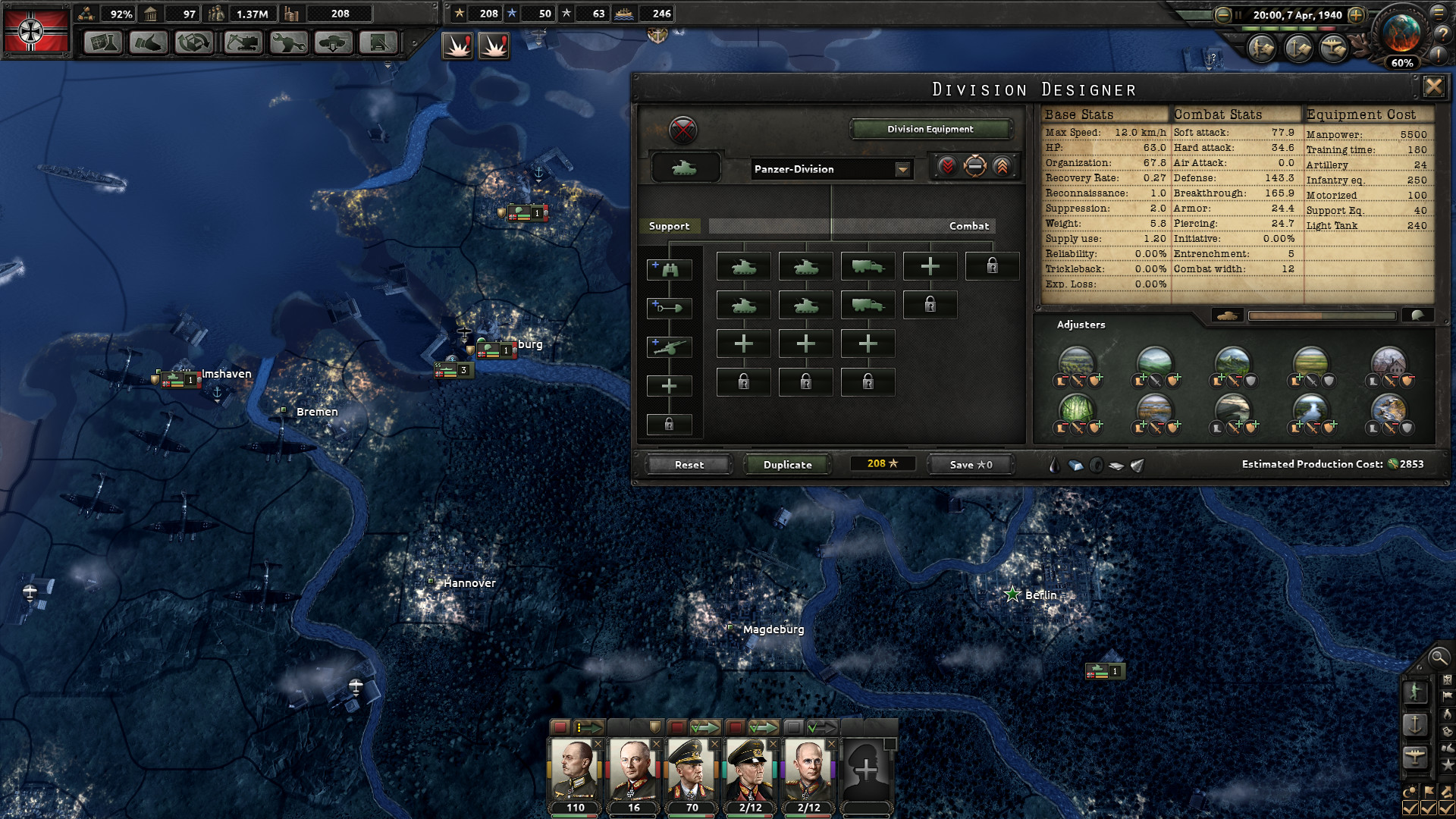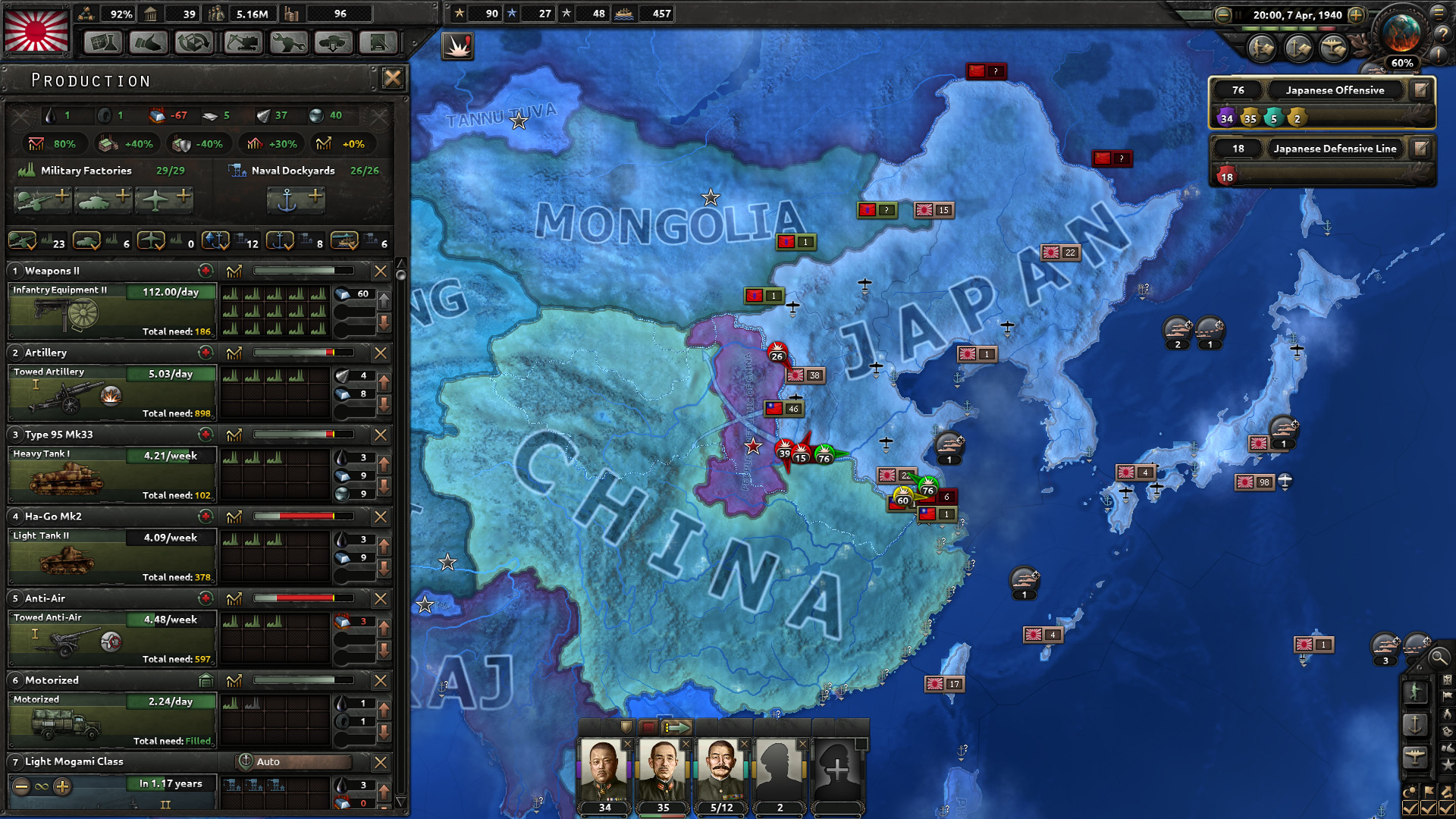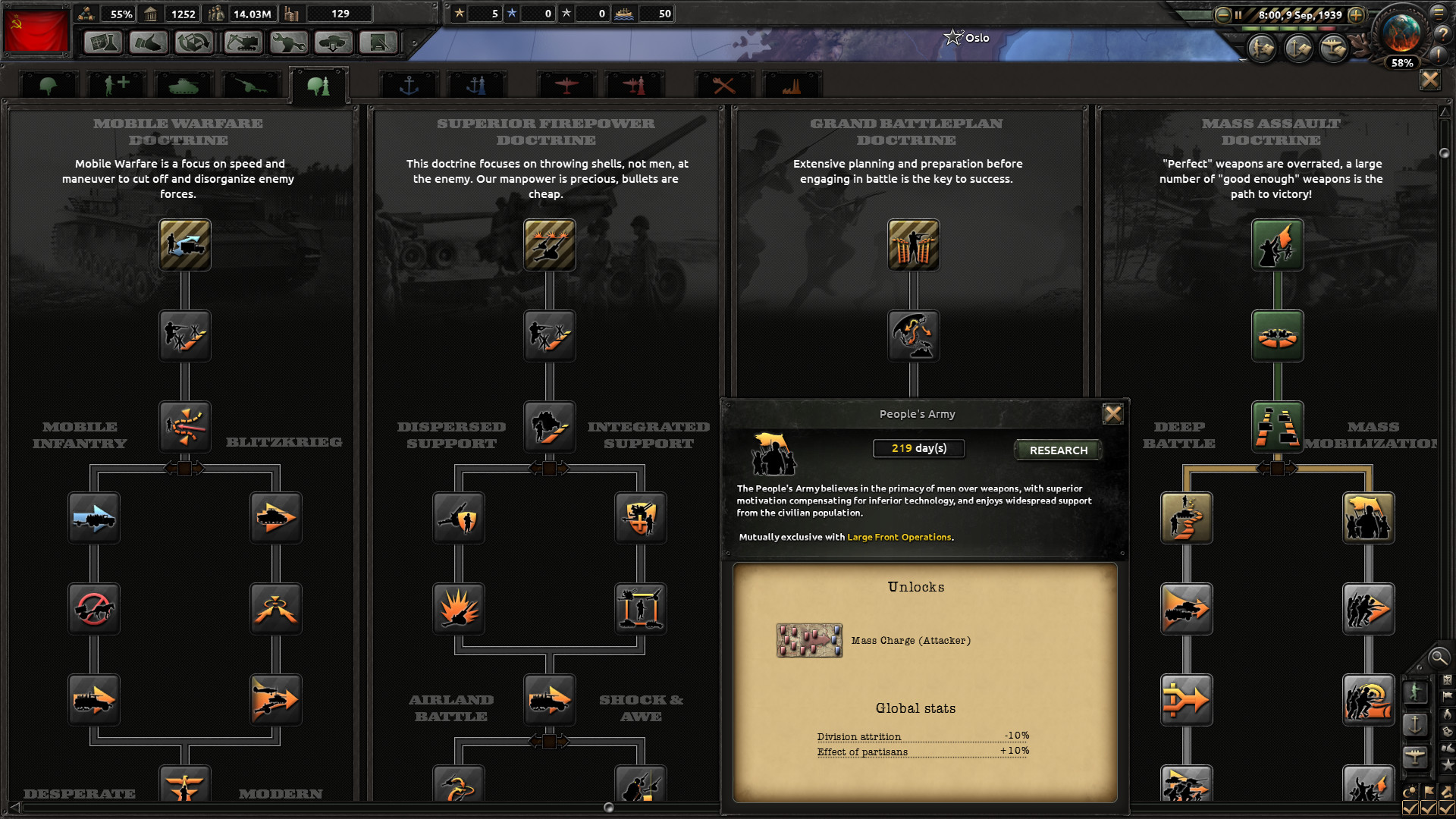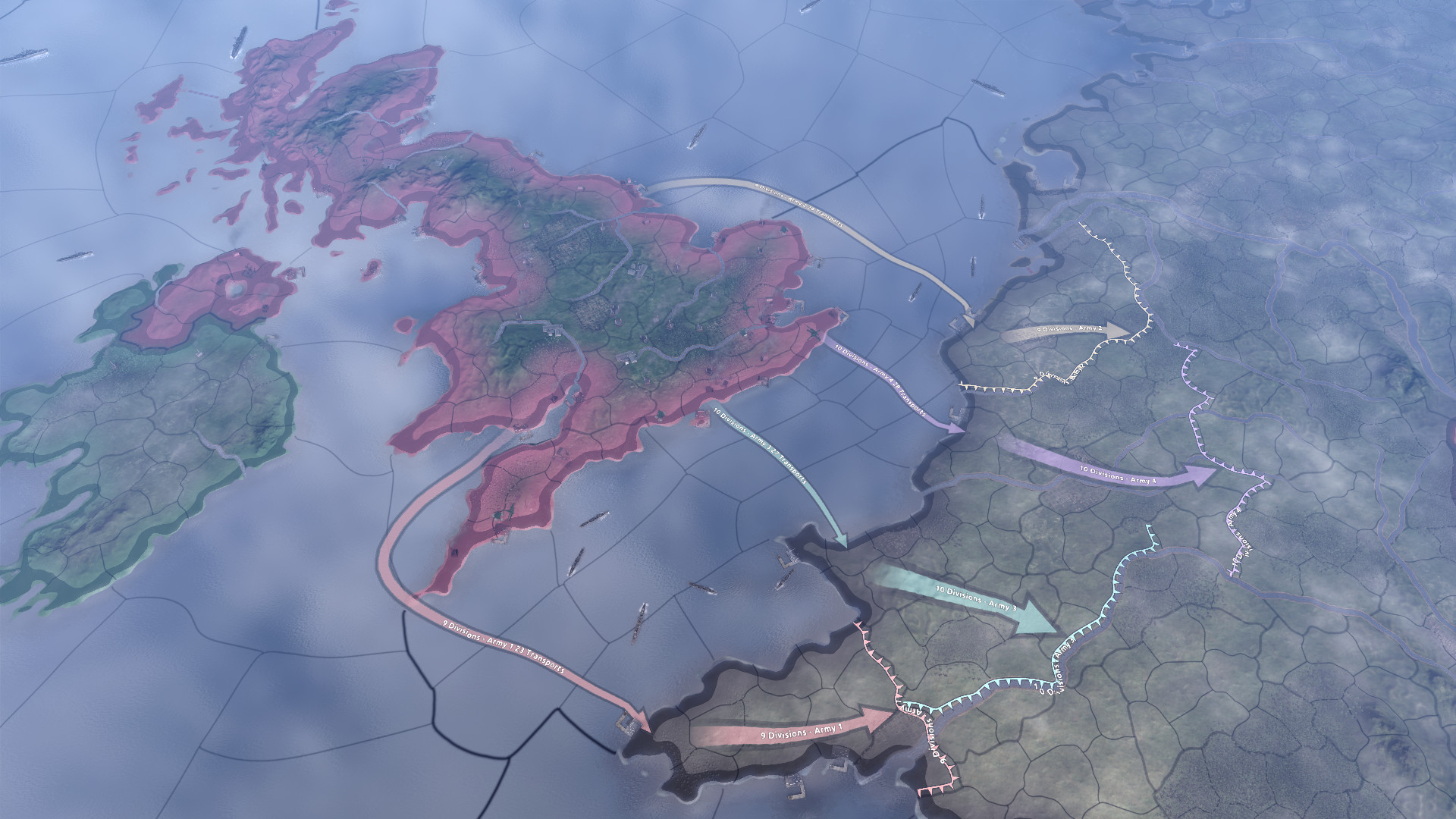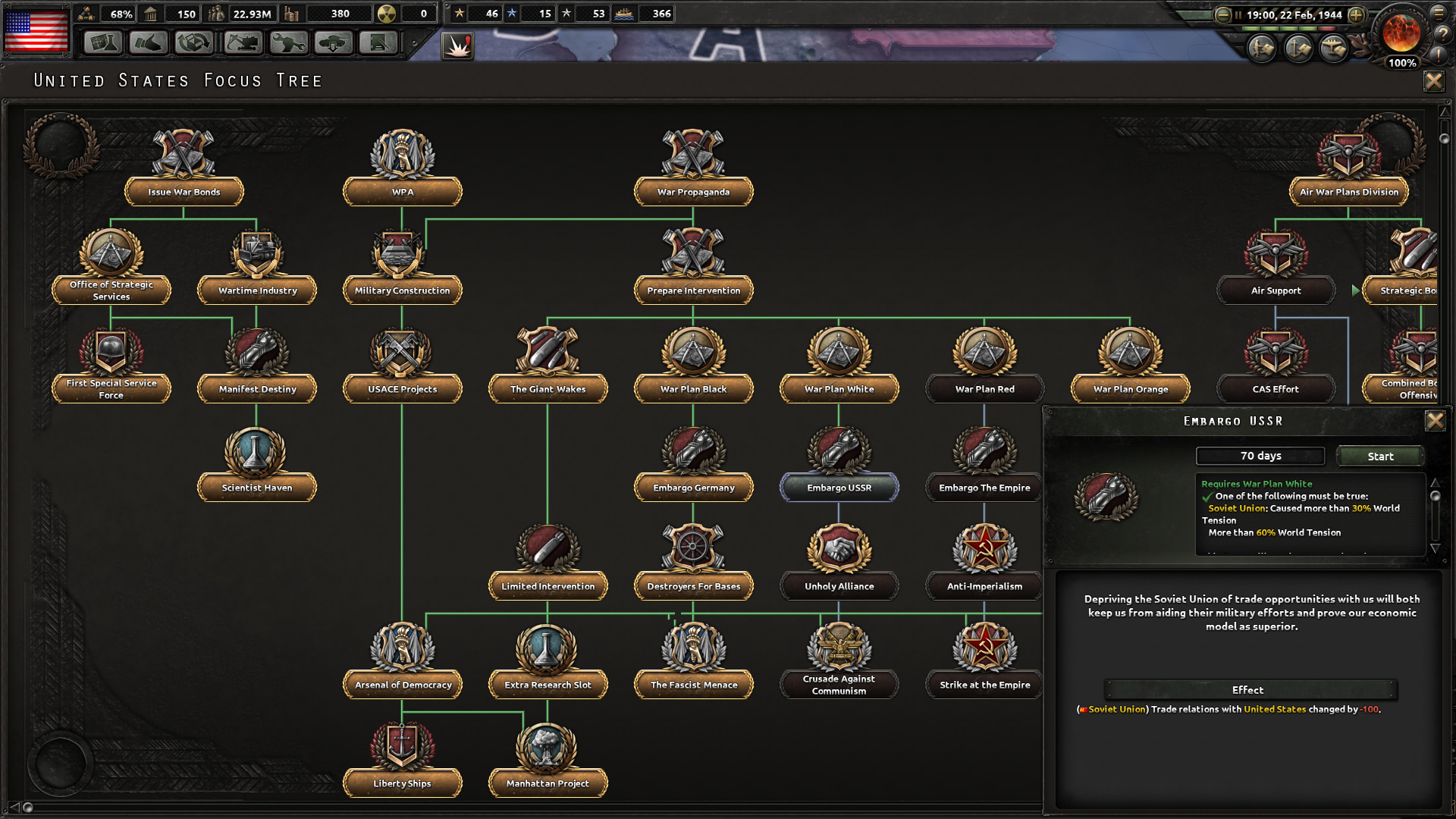Victory is at your fingertips! Your ability to lead your nation is your supreme weapon, the strategy game Hearts of Iron IV lets you take command of any nation in World War II; the most engaging conflict in world history.
From the heart of the battlefield to the command center, you will guide your nation to glory and wage war, negotiate or invade. You hold the power to tip the very balance of WWII.
It is time to show your ability as the greatest military leader in the world. Will you relive or change history? Will you change the fate of the world by achieving victory at all costs?
Main Features:
Everyone will receive:
From the heart of the battlefield to the command center, you will guide your nation to glory and wage war, negotiate or invade. You hold the power to tip the very balance of WWII.
It is time to show your ability as the greatest military leader in the world. Will you relive or change history? Will you change the fate of the world by achieving victory at all costs?
Main Features:
- Total strategic war: War is not only won on land, sea and in the air. It’s also achieved in the hearts and minds of men and women.
- Authentic real-time war simulation: Let the greatest commanders of WW2 fight your war with the tools of the time; tanks, planes, ships, guns and newly discovered weapons of mass destruction.
- Assume control of any nation: Choose from the greatest powers striving for victory, or the small nations trying to weather the storm.
- Turn the world into your battlefield: Experience the full WWII timespan in a topographical map complete with seasons, weather and terrain. Snow, mud, storms can be both your strong ally and a ruthless enemy.
- Negotiate or force your will: Experience the advanced politics and diplomacy systems, form factions, engage in trade for resources and appoint ministers to your party.
- Intense Online Combat: Battle in both competitive and cooperative multiplayer for up to 32 players. Featuring cross-platform multiplayer.
- Give your nation a unique edge: Experience the flexible technology system, where all major powers get their own unique identity. Develop detailed historic tanks and planes through research and army experience.
Everyone will receive:
- Poland: United and Ready:
A Free DLC adds a unique focus tree for Poland, new 3d models for tanks and planes, 2d assets, and extra leader portraits for the ultimate in historical accuracy.
- Forum Avatar
- Wallpaper
Developer Diary | Sweden Alt History

When your support for the cause is high enough, you can flip communist with the leader Nils Flyg. This guy definitely does not fit into the HoI mold as he became disillusioned with the Soviet Union and became pro-axis.

In game this means that the non-comforming Flyg can join the Axis (for the rest of you historical figures it would really help us if you only stuck to your designated 4 allowed ideologies please)

Flygs grip on power will be challenged by Karl Kilbom after a period of time, where you can choose to align more with the allies for a less radical future.
As you flip communist the fascists are not all too pleased and will start gathering support for a counterrevolution, eventually also dragging in the military if you wait too long. Preventing a counter revolution will expose the big ringleaders of the plot.

The ringleaders are 3 of your generals, and you get to decide what to do with them. Either you prosecute them for treason using the legal system, which retires them permanently but gives stability, or you promote them away from power where they can do any real harm, keeping them as generals but getting a debuff.

In any case fascism is crushed in the country and we now get to a cornerstone of the communist branch, socialist reforms. All those toasters that you used to throw away? They are now used for something

You also get to enact different policies that relates to consumer goods, turning your civilian population into a potential powerhouse.

To the left there are two refuge focuses. The first one is quite self explanatory.

The second allows Sweden to get foreign communist advisors depending on what focus path other countries are going for. In this example Portugal has gone down the Iberian Wedding path, Poland has gone with the April constitution and Ethiopia has gone down the Fascist path, so these advisors will flee to Sweden and become available. This list will grow or shrink depending on what other countries pick as their focus path. Regardless, the player will always get the specialized Communist Military Council.

State planning committee and Establish Politibury both expand on the consumer goods decisions and give some needed factories, while the Starve the fascists/allies of iron embargoes your future enemy and increases your output at the cost of consumer goods.

The end of the tree deals directly with your neighbors, for Norway and Denmark you can more easily influence them and eventually topple their government in a civil war for that James Bond () spy experience.

The Finnish version is more about actively helping the Finns and use them as a buffer state against a potential angry USSR.

The capstone focus of the tree is when you offer everyone a base minimum income, which will help with newly conquered states compliance. At the end the path merges with the late game focuses as described in the first DD.
As you might see, a lot of this path is focused on using consumer goods in a beneficial way. You can control how much/little goods you spend, thus increasing the strength of Folkhemmet at the cost of your consumer industry.

In this extreme example I have gained a lot of bonuses

But it has also resulted in my civilian economy tanking.
Previously if you were under a % stability threshold the game would roll a die each month, and if the player were unlucky enough they would get strikes. While being under the threshold had the desired effect being at unease I never liked putting the player at the hands of RNGesus for such a critical component.
The most likely outcome if a player got a bad roll would probably just be reloading from the latest autosave, which was something I wanted to avoid.

The system is now more deterministic. The player can always see the conditions for the strikes starting to tick down, and it gives you some time to adjust your strategy accordingly, which is a more fair system. If you have ever played Mexico this might look familiar to you.
The Nordic defense council branch also got some additions. There are some new focuses, and the entire branch now hooks directly into the tail end of the democratic branch so that it is no longer just a dead end..

And if you get to a fully powered council you get to build the ultimate battleship, but it might sink your economy for a little while.

If you are unlucky and no one accepts your invitation, you can now coax them to join, so even if no one initially joins its not game over and you have to restart.

And here is the council portrait itself


Raoul Wallenberg is now an advisor and operative and Sweden now gets a snow focused armored car

As you can see Germany and France still get axed in regards to some of their steel production, but not as bad as before. With the drastically reduced steel production presented in the first dev diary Germany had no option to go on any other law (unless spending massive amounts of resources on trade).
While making Germany more reliant on trade and reducing the overabundance on steel that the game has, essentially allowing Germany and France to bypass a lot of the resource aspect of the game was a goal, I did not want to force players to be on limited trade and that was the end all be all, which would be the same as free trade being the end all be all before.

Now a German player has the ability to go on Free Trade while still hovering on the green (barely) at game start with no additional mils (using the starting lines).
If the goal is to build civs for the first years of the game free trade might still be lucrative for you, but once you start ramping up military production you will probably be forced to change laws.
Vice versa if you are more into a mil rush build you might want to bump the law to export focus instead.
France instead has gained some steel from before, mostly due to Africa.

Northern Africa's deposits are now more abundant than before (note that you dont access it all due to compliance at the start but can unlock it all with the Blum -Violette proposal). My hope is that it is gonna incentivize the Northern African campaign from both sides, with the allies wanting to secure the steel and the axis wanting to claim it.
As you can see the UK has also gained some resources, those are from the Sierra Leone and Ghana mines

This is to give a larger purpose to areas of Africa that historically in game has had little reason of justification to hold or conquer. The real value of the steel is a bit higher than is presented here but is lower due to occupation and compliance.

Germany also has 1 new focus where it can gain resource rights for Vsterbotten, giving them a nice 49 tungsten, 55 steel and 21 chromium, and some nice buffs to Swedens economy

Additionally Operation Weserbung now has the additional effect of adding civilian factories if Germany controls Narvik. This hopefully will add some extra incentive to control the port. However this also gives the option of the UK launching Plan R 4

If the UK invades Narvik they can be given the option to go into Sweden, blow up the Swedish iron ore mines and get out. Successfully doing this will remove all the civilian factories that Germany has gotten from controlling Narvik, and sabotaging the Swedes mines. It will also give the UK the option to white peace Sweden to avoid a full scale Swedish war. This will only be available for a short period though as if you fail the operation the public will see through the charade of we are just trying to help the Finns, leading to a large drop in stability.
Currently the resource gained from compliance has also been increased from 60% to 65%, but as always balance is in flux and these might be changed later. Germany still starts with 2 extra civs.

The National Socialist movement in Sweden during this time period, while active and visible, was unsuccessful in gaining much traction with the public. There were many reasons for this, but we shall try to summarize the main points. Perhaps the primary factor that undermined them, and the communists for that matter, was the success of the Social Democrats in providing a strong social safety net and employment for the masses. This meant people were less likely to be radicalized in the same way that occurred in Germany or Italy following the Great Depression. Furthermore, there were multiple National Socialist parties all bickering with one another, keeping the movement fragmented.
Geo-political factors also contributed to undermining far-right activity. The historic animosity with Russia led many to see communism as a Trojan horse for Russia to gain influence over Swedish affairs. This prevented the communists gaining too much support and in turn prevented large numbers of would-be National Socialists joining movements to curtail them, as had occurred in Weimar Germany following WWI. Furthermore, Swedish neutrality over the previous century meant there was little appetite for the militaristic rhetoric that was so successful in other nations of the time period and there were no seriously pressing territorial disputes that could be called upon to galvanize the public against a common foe. Instead, most of the public supported the nations continued neutrality, save for the Winter War when many Swedes were prepared to fight in defense of their eastward neighbor, Finland.
As mentioned above, the far-right in Sweden were predominantly National Socialist in character and this would ultimately be the undoing of the far-right in Sweden. Once World War II began there was a shift in Swedish attitudes against National Socialism, due to the threat Germany now posed to Swedish independence. While there were those of a Quisling persuasion who hoped to be swept to power by a German occupation of Sweden, the National Socialist Movement fragmented further and was forced to drop their militaristic uniforms and tone down their rhetoric to maintain any semblance of support among the public.
With regards to the monarchy during this period, King Gustaf V had reigned since 1907 and had overseen the transition of the nation from a highly centralized power structure around himself, to a constitutional monarchy with universal suffrage. While there was much controversy over the Kings actions during the time period and high proportion of aristocrats in positions of power in the military, there was no movement advocating for the return to absolute monarchy.

Given all of this, you might be wondering if we even bothered to make a fascist or monarchist path for Sweden. Well, rest assured that we did. And whilst it took some time to figure out how to do it, I think we were successful in creating some engaging alt-history narratives that give players an immersive experience into how different things could have been in little old Sweden. So lets get into it.

As youre well aware by now, the National Socialists and the monarchy both suffered from similar issues and their supporters shared common grievances. Therefore, the path to restoring the monarchy or installing a National Socialist regime are initially the same. By taking the focus The Old Enemy Stirs players can use the publics fear of the Soviet Union and communism to gain support for their nationalist agenda. Players will have to walk a tightrope between lowering stability enough to gain support for radical political changes, while not enraging the political opposition too hastily and triggering civil disobedience.
The first real choice in this path is between undermining the fascists or revoking the anti-militia laws. Undermine the fascists will put the player on the path towards restoring the powers of the King and becoming an absolute monarchy once more.

Meanwhile, Revoke the Anti-Militia Laws will lead to the National Socialist movement coming to power. The historical context for this focus comes from 1931 when the Munckska kren, a paramilitary organization of anti-communists were unveiled which led to a debate over such groups among the public. In 1934, the government would outlaw such organizations before they could get out of hand. This prevented the same sort of street violence that occurred in other nations during the time period, but in this scenario we are reversing course. In game play terms, this will allow players to recruit Stormtrupper militia divisions. These will be crucial to the player should the nation be embroiled in a civil war.
The following focus is shared between the monarchist and National Socialist branch, but allows the player to increase support for their respective ideology via decisions. However, these boosts in support will come at a price. Once democracy is suspended, missions will be activated whereby the player must fulfill their obligations to these benefactors, or face severe hits to stability.



On the National Socialist Side, another path must be chosen between pursuing a purely independent movement in Sweden, or approaching the German Reich for support. Gaining the support of Germany will be the easiest path for changing ideology and offers great rewards, however it will come at the cost of becoming their puppet. At least for now

Let's take a closer look at the Delegation to Berlin sub-branch first. As you can see, there are multiple mutually exclusive focuses here that allow the player to tweak the nation to their play style. While many will be content to fight alongside the Axis as a puppet, there are those who enjoy the challenge of overthrowing an overlord, both options are viable here. The path culminates in a decision to become the master of Scandinavia in the German sphere of influence or to backstab the Germans by declaring an independent Swedish Reich and attempting to defeat them militarily. Timing your betrayal of Germany with the war turning against them can be extremely fun.

Over in the independent part of the branch, the path to power requires gaining enough support to orchestrate a putsch. With the country undergoing so much internal turmoil in such a short space of time, the following focus gives a boost to rebuilding the nation and preventing adversaries from undermining the new regime via espionage.

If a monarchist play through is more your interest, youll have noticed the Meet With the King branch. This section was inspired by three main factors, one being the historic ties between the Swedish royal family and Germany. The Kings wife, Queen Victoria, was one of many royals of German descent for example. These historic ties lead many to believe that King Gustaf was somewhat sympathetic to Germany during the time period. This wasnt helped by him writing to Hitler of his support for the invasion of the Soviet Union in 1941. The second factor that influenced our narrative was that the King invited the leader of the National Socialist party, Sven Olav Lindholm to the royal palace for a meeting. The third factor in our narrative was King Gustafs willingness to insert himself into political discussions despite the undemocratic nature of doing so. For example, in 1940 he threatened to abdicate as a means of forcing his preferred policy option during the midsummer crisis.
In our monarchist path, weve expanded on these factors so that we can see what might have happened if the King had been a little bit more politically active. The Meet With the King focus triggers an event for unifying the nationalist movements of the nation under the banner of the King. Decisions are then unlocked to boost support for the King and the restoration of his authority. In order for this to work, the authority of the Social Democrats and the unions has to be undermined in the following focus. Finally, with enough support and destabilization, the King can return to power as absolute ruler.

Now, with either the King or the National Socialists in power, we come to The Counter Revolution and the job of rebuilding Sweden upon a new ideology. This focus triggers the previously mentioned missions for fulfilling obligations to the supporters of your chosen movement as well as removing the Social Democrats Folkhemmet national spirit. This in turn allows the nation to more rapidly expand the military at the expense of stability. You may have noticed a number of hits to stability in this branch of the tree, this is because we wanted the process of changing Sweden from a well established, neutral democracy to a more authoritarian government to feel challenging.

Finally we come to the foreign policy aspect of this alt-history branch, which unsurprisingly allows for multiple expansionist opportunities at the expense of your neighbors. While we wont go into every possible route today, the overarching theme for initial expansion is similar to Germany in the 1930s. These focuses give Sweden the opportunity to create an international crisis over small territorial disputes with their neighbors that ultimately undermines the integrity of said neighbors and allows Sweden to eventually conquer or puppet them.

However, we also have more co-operative methods of foreign policy here too. Sweden has the opportunity to approach the Allies and join their faction in exchange for Swedens historical overseas territories being returned to them. If accepted, Germany will be starved of much needed Swedish resources during the war and give Sweden territory in the Caribbean, Africa and India.

To the opposite end of this branch, we have opportunities to cooperate with the Axis and Finland in their dealings with the Soviet Union. This side culminates in Sweden gaining claims on the lands of Eastern Europe that once had historical ties to the Swedish vikings in centuries past. For those unaware, much of Russia and Ukraine was invaded or colonized by vikings who used the river networks of the region to navigate deep into the continent. While this may seem far fetched at first, its not unheard of for nationalistic movements to demand some sort of ownership of distant lands due to long forgotten or dubious claims. So it seems fitting that such a movement in Sweden would make such outlandish claims too. Plus, youre still going to have to conquer and occupy those regions which offer interesting challenges.

The ultimate culmination of this branch though, is the creation of the Greater Nordic Reich. This focus allows Sweden to fully integrate the Nordic regions of their empire, gaining greater access to their resources and manpower.

Thats it for this week's dev diary! Hopefully you enjoyed this foray into alternate history Sweden and are looking forward to playing it for yourself in the not so distant future! Next weeks diary will be on alternate history Denmark with Daniel. See ya!
Good morning/evening/night!
Summer break is over here in Sweden, most of the team is back from vacation and it's full steam ahead towards the finnish line. As mentioned in the last Swedish DD theres two designers for the Swedish tree, so you might see both of us answer in the comments below. Without further ado
Communist Sweden
In game the path to communist Sweden is to the left side (we finally managed to have the communist path on the left and the fascist one one the right) of the democratic historical path where you instead choose to align with the Swedish trade union to unlock some communist advisors
When your support for the cause is high enough, you can flip communist with the leader Nils Flyg. This guy definitely does not fit into the HoI mold as he became disillusioned with the Soviet Union and became pro-axis.

In game this means that the non-comforming Flyg can join the Axis (for the rest of you historical figures it would really help us if you only stuck to your designated 4 allowed ideologies please)

Flygs grip on power will be challenged by Karl Kilbom after a period of time, where you can choose to align more with the allies for a less radical future.
As you flip communist the fascists are not all too pleased and will start gathering support for a counterrevolution, eventually also dragging in the military if you wait too long. Preventing a counter revolution will expose the big ringleaders of the plot.

The ringleaders are 3 of your generals, and you get to decide what to do with them. Either you prosecute them for treason using the legal system, which retires them permanently but gives stability, or you promote them away from power where they can do any real harm, keeping them as generals but getting a debuff.

In any case fascism is crushed in the country and we now get to a cornerstone of the communist branch, socialist reforms. All those toasters that you used to throw away? They are now used for something

You also get to enact different policies that relates to consumer goods, turning your civilian population into a potential powerhouse.

To the left there are two refuge focuses. The first one is quite self explanatory.

The second allows Sweden to get foreign communist advisors depending on what focus path other countries are going for. In this example Portugal has gone down the Iberian Wedding path, Poland has gone with the April constitution and Ethiopia has gone down the Fascist path, so these advisors will flee to Sweden and become available. This list will grow or shrink depending on what other countries pick as their focus path. Regardless, the player will always get the specialized Communist Military Council.

State planning committee and Establish Politibury both expand on the consumer goods decisions and give some needed factories, while the Starve the fascists/allies of iron embargoes your future enemy and increases your output at the cost of consumer goods.

The end of the tree deals directly with your neighbors, for Norway and Denmark you can more easily influence them and eventually topple their government in a civil war for that James Bond () spy experience.

The Finnish version is more about actively helping the Finns and use them as a buffer state against a potential angry USSR.

The capstone focus of the tree is when you offer everyone a base minimum income, which will help with newly conquered states compliance. At the end the path merges with the late game focuses as described in the first DD.
As you might see, a lot of this path is focused on using consumer goods in a beneficial way. You can control how much/little goods you spend, thus increasing the strength of Folkhemmet at the cost of your consumer industry.

In this extreme example I have gained a lot of bonuses

But it has also resulted in my civilian economy tanking.
Small changes since last time
There's some small changes since the last DD that I think I should mention, first of which are changes to how Hungershield works.Previously if you were under a % stability threshold the game would roll a die each month, and if the player were unlucky enough they would get strikes. While being under the threshold had the desired effect being at unease I never liked putting the player at the hands of RNGesus for such a critical component.
The most likely outcome if a player got a bad roll would probably just be reloading from the latest autosave, which was something I wanted to avoid.

The system is now more deterministic. The player can always see the conditions for the strikes starting to tick down, and it gives you some time to adjust your strategy accordingly, which is a more fair system. If you have ever played Mexico this might look familiar to you.
The Nordic defense council branch also got some additions. There are some new focuses, and the entire branch now hooks directly into the tail end of the democratic branch so that it is no longer just a dead end..

And if you get to a fully powered council you get to build the ultimate battleship, but it might sink your economy for a little while.

If you are unlucky and no one accepts your invitation, you can now coax them to join, so even if no one initially joins its not game over and you have to restart.

And here is the council portrait itself


Raoul Wallenberg is now an advisor and operative and Sweden now gets a snow focused armored car

Resource balance boggolo two
Unrelated to Sweden here are some new numbers on the upcoming steel changes coming in the accompanying patch. All stats are at game start (36), with infrastructure and no production lines. The (start) rows are with the starting trade law of the country, while (total) is on closed economy.| Steel (start) | 381 | 253 | -128 |
| Steel (Total) | 508 | 284 | -224 |
| Austria | - | - | - |
| Steel (start) | 5 | 15 | 10 |
| Steel (Total) | 10 | 29 | 19 |
| France | - | - | - |
| Steel (start) | 457 | 313 | -144 |
| Steel (Total) | 914 | 625 | -289 |
| UK | - | - | - |
| Steel (start) | 229 | 262 | 33 |
| Steel (Total) | 452 | 524 | 72 |
As you can see Germany and France still get axed in regards to some of their steel production, but not as bad as before. With the drastically reduced steel production presented in the first dev diary Germany had no option to go on any other law (unless spending massive amounts of resources on trade).
While making Germany more reliant on trade and reducing the overabundance on steel that the game has, essentially allowing Germany and France to bypass a lot of the resource aspect of the game was a goal, I did not want to force players to be on limited trade and that was the end all be all, which would be the same as free trade being the end all be all before.

Now a German player has the ability to go on Free Trade while still hovering on the green (barely) at game start with no additional mils (using the starting lines).
If the goal is to build civs for the first years of the game free trade might still be lucrative for you, but once you start ramping up military production you will probably be forced to change laws.
Vice versa if you are more into a mil rush build you might want to bump the law to export focus instead.
France instead has gained some steel from before, mostly due to Africa.

Northern Africa's deposits are now more abundant than before (note that you dont access it all due to compliance at the start but can unlock it all with the Blum -Violette proposal). My hope is that it is gonna incentivize the Northern African campaign from both sides, with the allies wanting to secure the steel and the axis wanting to claim it.
As you can see the UK has also gained some resources, those are from the Sierra Leone and Ghana mines

This is to give a larger purpose to areas of Africa that historically in game has had little reason of justification to hold or conquer. The real value of the steel is a bit higher than is presented here but is lower due to occupation and compliance.

Germany also has 1 new focus where it can gain resource rights for Vsterbotten, giving them a nice 49 tungsten, 55 steel and 21 chromium, and some nice buffs to Swedens economy

Additionally Operation Weserbung now has the additional effect of adding civilian factories if Germany controls Narvik. This hopefully will add some extra incentive to control the port. However this also gives the option of the UK launching Plan R 4

If the UK invades Narvik they can be given the option to go into Sweden, blow up the Swedish iron ore mines and get out. Successfully doing this will remove all the civilian factories that Germany has gotten from controlling Narvik, and sabotaging the Swedes mines. It will also give the UK the option to white peace Sweden to avoid a full scale Swedish war. This will only be available for a short period though as if you fail the operation the public will see through the charade of we are just trying to help the Finns, leading to a large drop in stability.
Currently the resource gained from compliance has also been increased from 60% to 65%, but as always balance is in flux and these might be changed later. Germany still starts with 2 extra civs.
Fascism and Monarchism
Lets dive into the other ideological alternate history paths for Sweden, those being monarchism and fascism. It isnt really accurate to categorize Swedish far-right activity during this period as simply fascist. The public were largely disdainful of Italian style fascism, seeing it as a foreign ideology trying to undermine the foundations of their nation, much the same as they viewed communism. Instead, many would-be fascists looked to German National Socialism for inspiration due to the strong cultural and economic links between Sweden and Germany. While this would make the movement more palatable to Swedes, it would have repercussions for the movement in the long-run.
The National Socialist movement in Sweden during this time period, while active and visible, was unsuccessful in gaining much traction with the public. There were many reasons for this, but we shall try to summarize the main points. Perhaps the primary factor that undermined them, and the communists for that matter, was the success of the Social Democrats in providing a strong social safety net and employment for the masses. This meant people were less likely to be radicalized in the same way that occurred in Germany or Italy following the Great Depression. Furthermore, there were multiple National Socialist parties all bickering with one another, keeping the movement fragmented.
Geo-political factors also contributed to undermining far-right activity. The historic animosity with Russia led many to see communism as a Trojan horse for Russia to gain influence over Swedish affairs. This prevented the communists gaining too much support and in turn prevented large numbers of would-be National Socialists joining movements to curtail them, as had occurred in Weimar Germany following WWI. Furthermore, Swedish neutrality over the previous century meant there was little appetite for the militaristic rhetoric that was so successful in other nations of the time period and there were no seriously pressing territorial disputes that could be called upon to galvanize the public against a common foe. Instead, most of the public supported the nations continued neutrality, save for the Winter War when many Swedes were prepared to fight in defense of their eastward neighbor, Finland.
As mentioned above, the far-right in Sweden were predominantly National Socialist in character and this would ultimately be the undoing of the far-right in Sweden. Once World War II began there was a shift in Swedish attitudes against National Socialism, due to the threat Germany now posed to Swedish independence. While there were those of a Quisling persuasion who hoped to be swept to power by a German occupation of Sweden, the National Socialist Movement fragmented further and was forced to drop their militaristic uniforms and tone down their rhetoric to maintain any semblance of support among the public.
With regards to the monarchy during this period, King Gustaf V had reigned since 1907 and had overseen the transition of the nation from a highly centralized power structure around himself, to a constitutional monarchy with universal suffrage. While there was much controversy over the Kings actions during the time period and high proportion of aristocrats in positions of power in the military, there was no movement advocating for the return to absolute monarchy.

Given all of this, you might be wondering if we even bothered to make a fascist or monarchist path for Sweden. Well, rest assured that we did. And whilst it took some time to figure out how to do it, I think we were successful in creating some engaging alt-history narratives that give players an immersive experience into how different things could have been in little old Sweden. So lets get into it.

As youre well aware by now, the National Socialists and the monarchy both suffered from similar issues and their supporters shared common grievances. Therefore, the path to restoring the monarchy or installing a National Socialist regime are initially the same. By taking the focus The Old Enemy Stirs players can use the publics fear of the Soviet Union and communism to gain support for their nationalist agenda. Players will have to walk a tightrope between lowering stability enough to gain support for radical political changes, while not enraging the political opposition too hastily and triggering civil disobedience.
The first real choice in this path is between undermining the fascists or revoking the anti-militia laws. Undermine the fascists will put the player on the path towards restoring the powers of the King and becoming an absolute monarchy once more.

Meanwhile, Revoke the Anti-Militia Laws will lead to the National Socialist movement coming to power. The historical context for this focus comes from 1931 when the Munckska kren, a paramilitary organization of anti-communists were unveiled which led to a debate over such groups among the public. In 1934, the government would outlaw such organizations before they could get out of hand. This prevented the same sort of street violence that occurred in other nations during the time period, but in this scenario we are reversing course. In game play terms, this will allow players to recruit Stormtrupper militia divisions. These will be crucial to the player should the nation be embroiled in a civil war.
The following focus is shared between the monarchist and National Socialist branch, but allows the player to increase support for their respective ideology via decisions. However, these boosts in support will come at a price. Once democracy is suspended, missions will be activated whereby the player must fulfill their obligations to these benefactors, or face severe hits to stability.



On the National Socialist Side, another path must be chosen between pursuing a purely independent movement in Sweden, or approaching the German Reich for support. Gaining the support of Germany will be the easiest path for changing ideology and offers great rewards, however it will come at the cost of becoming their puppet. At least for now

Let's take a closer look at the Delegation to Berlin sub-branch first. As you can see, there are multiple mutually exclusive focuses here that allow the player to tweak the nation to their play style. While many will be content to fight alongside the Axis as a puppet, there are those who enjoy the challenge of overthrowing an overlord, both options are viable here. The path culminates in a decision to become the master of Scandinavia in the German sphere of influence or to backstab the Germans by declaring an independent Swedish Reich and attempting to defeat them militarily. Timing your betrayal of Germany with the war turning against them can be extremely fun.

Over in the independent part of the branch, the path to power requires gaining enough support to orchestrate a putsch. With the country undergoing so much internal turmoil in such a short space of time, the following focus gives a boost to rebuilding the nation and preventing adversaries from undermining the new regime via espionage.

If a monarchist play through is more your interest, youll have noticed the Meet With the King branch. This section was inspired by three main factors, one being the historic ties between the Swedish royal family and Germany. The Kings wife, Queen Victoria, was one of many royals of German descent for example. These historic ties lead many to believe that King Gustaf was somewhat sympathetic to Germany during the time period. This wasnt helped by him writing to Hitler of his support for the invasion of the Soviet Union in 1941. The second factor that influenced our narrative was that the King invited the leader of the National Socialist party, Sven Olav Lindholm to the royal palace for a meeting. The third factor in our narrative was King Gustafs willingness to insert himself into political discussions despite the undemocratic nature of doing so. For example, in 1940 he threatened to abdicate as a means of forcing his preferred policy option during the midsummer crisis.
In our monarchist path, weve expanded on these factors so that we can see what might have happened if the King had been a little bit more politically active. The Meet With the King focus triggers an event for unifying the nationalist movements of the nation under the banner of the King. Decisions are then unlocked to boost support for the King and the restoration of his authority. In order for this to work, the authority of the Social Democrats and the unions has to be undermined in the following focus. Finally, with enough support and destabilization, the King can return to power as absolute ruler.

Now, with either the King or the National Socialists in power, we come to The Counter Revolution and the job of rebuilding Sweden upon a new ideology. This focus triggers the previously mentioned missions for fulfilling obligations to the supporters of your chosen movement as well as removing the Social Democrats Folkhemmet national spirit. This in turn allows the nation to more rapidly expand the military at the expense of stability. You may have noticed a number of hits to stability in this branch of the tree, this is because we wanted the process of changing Sweden from a well established, neutral democracy to a more authoritarian government to feel challenging.

Finally we come to the foreign policy aspect of this alt-history branch, which unsurprisingly allows for multiple expansionist opportunities at the expense of your neighbors. While we wont go into every possible route today, the overarching theme for initial expansion is similar to Germany in the 1930s. These focuses give Sweden the opportunity to create an international crisis over small territorial disputes with their neighbors that ultimately undermines the integrity of said neighbors and allows Sweden to eventually conquer or puppet them.

However, we also have more co-operative methods of foreign policy here too. Sweden has the opportunity to approach the Allies and join their faction in exchange for Swedens historical overseas territories being returned to them. If accepted, Germany will be starved of much needed Swedish resources during the war and give Sweden territory in the Caribbean, Africa and India.

To the opposite end of this branch, we have opportunities to cooperate with the Axis and Finland in their dealings with the Soviet Union. This side culminates in Sweden gaining claims on the lands of Eastern Europe that once had historical ties to the Swedish vikings in centuries past. For those unaware, much of Russia and Ukraine was invaded or colonized by vikings who used the river networks of the region to navigate deep into the continent. While this may seem far fetched at first, its not unheard of for nationalistic movements to demand some sort of ownership of distant lands due to long forgotten or dubious claims. So it seems fitting that such a movement in Sweden would make such outlandish claims too. Plus, youre still going to have to conquer and occupy those regions which offer interesting challenges.

The ultimate culmination of this branch though, is the creation of the Greater Nordic Reich. This focus allows Sweden to fully integrate the Nordic regions of their empire, gaining greater access to their resources and manpower.

Thats it for this week's dev diary! Hopefully you enjoyed this foray into alternate history Sweden and are looking forward to playing it for yourself in the not so distant future! Next weeks diary will be on alternate history Denmark with Daniel. See ya!
[ 2023-08-30 13:04:53 CET ] [Original Post]
Minimum Setup
- OS: OS: Ubuntu 20.04
- Processor: Intel Core 2 Quad Q9400 @ 2.66 GHz / AMD Athlon II X4 650 @ 3.20 GHzMemory: 4 GB RAM
- Memory: 4 GB RAM
- Graphics: ATI Radeon HD 5850 or NVIDIA GeForce GTX470 with 1GB VRAM / Latest available proprietary drivers from both manufacturers
- Storage: 2 GB available spaceAdditional Notes: Controller support: 3-button mouse. keyboard. and speakers are required. / Internet Connection or LAN for multiplayer. Up to 32 other players in multiplayer mode.
Recommended Setup
- OS: OS: Ubuntu 20.04
- Processor: Intel Core i5 750 @ 2.66 GHz / AMD Phenom II X4 955 @ 3.20 GHzMemory: 4 GB RAM
- Graphics: ATI Radeon HD 6950 or NVIDIA GeForce GTX570 with 2GB VRAM / Latest available proprietary drivers from both manufacturers
- Storage: 2 GB available spaceAdditional Notes: Controller support: 3-button mouse. keyboard. and speakers are required. / Internet Connection or LAN for multiplayer. Up to 32 other players in multiplayer mode.
GAMEBILLET
[ 6432 ]
FANATICAL
[ 7154 ]
GAMERSGATE
[ 3708 ]
MacGameStore
[ 5362 ]
FANATICAL BUNDLES
HUMBLE BUNDLES
by buying games/dlcs from affiliate links you are supporting tuxDB

